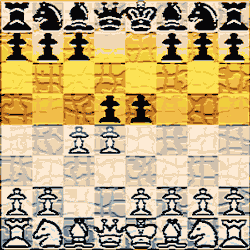Albin Master Mind Games
by Ashrafali
(Malappuram)
The following passage is taken from Michael Goeller's fantastic chess blog, The Kenilworthian:
The Albin Counter Gambit 1.d4 d5 2.c4 e5!? has been played and written about since it was first popularized by Adolf Albin in the 1890s. Recent use of the countergambit by GMs Morozevich and Nakamura has revived interest of late. During the early years of the gambit, White players tried a number of ideas until they hit upon the King's Bishop fianchetto with 3.dxe5 d4 4.Nf3 Nc6 5.g3, which remains a popular approach. Black usually responds then 5...Bg4, 5...Be6, or (most interestingly) 5...Bf5!?; but recent attention has focused on Morozevich's 5...Nge7!? (a move first used by Frank James Marshall and then by Ariel Mengarini).
With Black doing well with a variety of answers to 5.g3, attention has shifted to 5.Nbd2! which has been recomended (e.g. by Eric Schiller and Angus Dunnington) as the easiest anti-Albin line, but few sources discuss the Morozevich and Nakamura response of 5...Nge7, which may now be one of the most important theoretical lines for the evaluation of the Albin as a whole. Those that do discuss this line at all give 6.Nb3 Nf5 7.e4 dxe3 8.Qxd8+ Nxd8 (8...Kxd8 9.Bxe3! Nxe3 10.fxe3 += Bilguer!) 9.fxe3+= with an endgame edge for White as proven in several games.
Yet no GM has tried this widely accepted "refutation" against Morozevich or Nakamura! One can only guess that they assume the two are fully computer-prepped, and that the doubled e-pawns on an open file are a significant long-term weakness. My own analysis of these lines is far from conclusive and I do not feel confident in Black's chances.
Here is one good Albin-Counter Gambit game played by Morozevich in 2008.
Van Wely (2681) - Morozevich (2765)
D08
Blindfold, Rapid
Nice, 21.03.2008
1.d4
Dutch Master Loek Van Wely had the White pieces in this blindfold, rapid game against the Russian Master, Alexander Morozevich.
1...d5 2.c4
White plays the Queen's Gambit so what will Black's response be?
2...e5
Black takes the game into the Albin-Counter Gambit.
3.dxe5
Accepting the gambit is the strongest move.
3...d4
The Black pawn is simply pushed forward so as to be a menace in the White camp.
4.Nf3 Nc6
Simple development will follow in the next few moves.
5.Nbd2 Nge7 6.a3 Be6 7.g3 Qd7 8.Bg2 Bh3 9.0-0 Bxg2 10.Kxg2 0-0-0
Castling on opposite wings signals a fast and deadly game.
11.b4 Ng6 12.Bb2 h5 13.b5
Both sides playing for space.
13...Ncxe5 14.Bxd4 Nxf3 15.Nxf3 h4
Black wants to rip open the fortress in front of the enemy king.
16.Bxa7 Qg4 17.Qc2 hxg3
Just watch how quickly the Black pieces move into position to overwhelm the foe.
18.fxg3 b6
Not quite trapping the bishop but locking it out of the game.
19.a4 Bd6
The final assault begins.
20.e3
Giving the queen full access along the second rank.
20...Rh3
The second rook will replace the first at h8 forming a powerful battery.
21.Kh1
Allowing the queen to assist the other two defenders of the stressed pawn sitting on h2.
21...Rdh8 22.Rf2
A fourth defender.
22...Bxg3
The pressure is continuing to build.
23.Rg1
It looks as if White may hold the position but there is a winning sacrifice to hand.
23...Qxf3+!
White collapses in this rapid game after 23 quick fire moves. The reasons for White's resignation at this point are as follows:
23...Qxf3+ 24.Rgg2 (24.Rxf3 Rxh2+ 25.Qxh2 Rxh2#) 24...Rxh2+ 25.Kg1 Rh1#
0-1
Play through the moves of Van Wely - Morozevich yourself.









